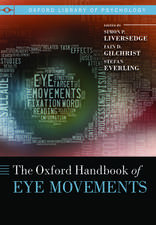Sensory Cue Integration: Computational Neuroscience Series
Editat de Julia Trommershauser, Konrad Kording, Michael S. Landyen Limba Engleză Hardback – 13 oct 2011
Preț: 816.78 lei
Preț vechi: 1226.98 lei
-33% Nou
Puncte Express: 1225
Preț estimativ în valută:
156.31€ • 161.48$ • 130.09£
156.31€ • 161.48$ • 130.09£
Carte tipărită la comandă
Livrare economică 14-20 martie
Preluare comenzi: 021 569.72.76
Specificații
ISBN-13: 9780195387247
ISBN-10: 0195387244
Pagini: 464
Ilustrații: 178 illustrations
Dimensiuni: 257 x 188 x 28 mm
Greutate: 1.29 kg
Ediția:New.
Editura: Oxford University Press
Colecția OUP USA
Seria Computational Neuroscience Series
Locul publicării:New York, United States
ISBN-10: 0195387244
Pagini: 464
Ilustrații: 178 illustrations
Dimensiuni: 257 x 188 x 28 mm
Greutate: 1.29 kg
Ediția:New.
Editura: Oxford University Press
Colecția OUP USA
Seria Computational Neuroscience Series
Locul publicării:New York, United States
Notă biografică
Julia Trommershäuser spent three years as a postdoctoral researcher at New York University. From 2004-2009, she was a researcher in the Department of Psychology at Giessen University, Germany, funded by an Emmy-Noether Research Award by the German Science Foundation (DFG). She currently works at the Center for Neural Science at New York University on questions in the field of human decision-making under risk and uncertainty.Konrad Körding is an Assistant Professor at Northwestern University. His lab focuses on the statistical processing of information in the sensorimotor system. Michael Landy is a Full Professor of Psychology and Neural Science at New York University. His research concerns visual and visuomotor behavior.





















